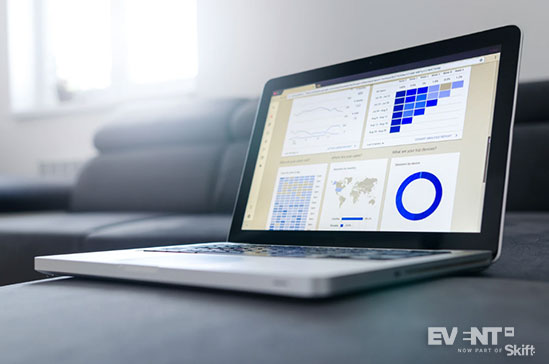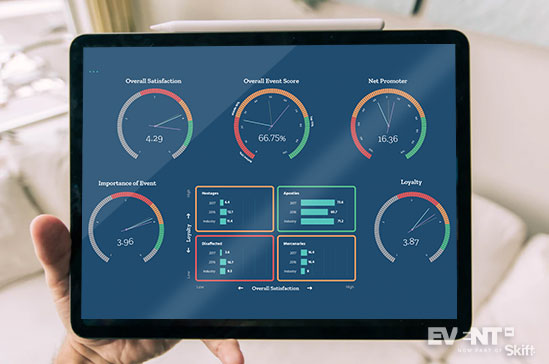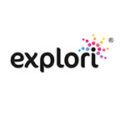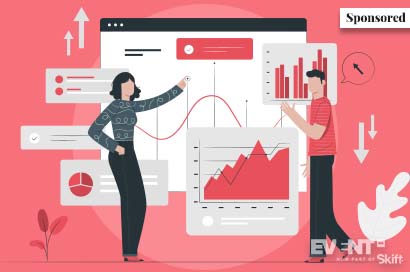This is a sponsored post from Explori. More information about Event Manager Blog’s sponsored posts.
It has never been more possible to track the entire attendee’s journey, but taking full advantage entails familiarizing yourself with all the different data sources and collection methods available. How do event planners get a complete picture of the attendee journey, and get it soon enough to be responsive when it counts?
The solution lies in the use of passive and active data collection in tandem. Each method brings its own advantages: passive data offers real-time engagement, sentiment and traffic data, and surveys are a effective method for collecting satisfaction statistics and adding nuance and context to your passive data.
In this article, we are going to explain the difference between active and passive data tracking and how to use them both in tandem. We will also have a look at why you should set up your data collection to track trends over time. Finally, we will review the best practices for data tracking using an active/passive combo strategy.
Data Collection 101
Tracking the attendee journey typically involves collecting three types of data: demographic (who your attendees are), engagement (what they are doing and when), and sentiment (why they are doing it) aspects of the attendee journey.
You can collect data at every stage of the event process:
-
Before
The registration process is a good time to collect information on demographics, interests, and expectations.
-
During
You can collect data on session engagement and attendance, speaker performance, booth/area attractiveness, who your attendees are engaging with, etc.
-
After
You can get feedback on the overall event experience through post-event surveys.
The main question is to figure out which type of data is going to tell you what you need to know (is it demographics, footfall, opinions, etc.?).
Hint
For a complete picture of the attendee experience, you should probably collect data on all of those aspects. Indeed, engagement data can provide hard facts for understanding what elements attendees interacted with the most, while sentiment data can contextualize it to offer insight into the efficacy of those interactions and the ‘why’ of the patterns that emerge.
Active Data Tracking
Role
Active data tracking tools involves soliciting feedback from attendees who actively provide it.
Types
Two main types of tools are used for active data tracking:
Surveys. Surveys and questionnaires disseminated before, during or after the event generate a range of data, like practical logistical information derived from multiple choice selections, quantitative sentiment data derived from binary questions and ratings, and qualitative feedback derived from open-ended questions. Surveys can be distributed via an event app, email campaign, social media messages or survey platform like Explori.
Pro Tip
Standardizing your survey questions will help you compare results from event to event and across your organization. Explori facilitates this comparison over time by providing surveys that incorporate standard, template-like questions.
Polls. These short questionnaires usually require a binary answer and are best suited for right after a session to assess a specific topic or impression. They can be conducted through the event app or a chatbot.
Benefits
Discovering more about your attendees
Surveys can be used before the event to discover attendees’ objectives, expectations and interests. These pre-event surveys tell you who they are, what they are most interested in, what they expect to get from attending the event, etc.
All of this data is essential for tailoring your event to your attendees and offering as personalized an experience as possible.
Proving event impact
Surveys are an effective way to prove the impact of events on attendees’ intention to purchase, return next year, etc.
Let’s say one of your company’s goals is to increase sales referrals by 30% over the next 12 months. In measuring NPS scores after the event and comparing them to the company’s overall NPS averages, an event organizer can bring to light the capacity of an event to increase an attendee’s intention to recommend.
Pro Tip
Shorter surveys throughout the event alleviate the burden of collecting all the information afterwards, so you don’t end up with a 40-question survey that attendees are not going to bother completing. However, be mindful of survey fatigue. Don’t send too many, limit questions to one to three, and choose a delivery method that allows for fast and seamless responses, like via the event app.


Contextualizing data for more actionable insights
Surveys that include open-ended questions allow respondents to explain the reasons for their ratings and other feedback. For example, if a post-session survey revealed that attendees didn’t derive a lot of value from the experience, an open-ended question might indicate why (e.g. the speaker was difficult to hear, or the topic coverage was too basic).
Combining this sentiment data with the passive data you collect adds context for your analysis, and generates more actionable insights. For example, combining wearables data with survey data allows organisers to understand which engagement behaviors are similar across attendees who align with their impact objectives. Organizers could identify that attendees who were at the keynote had greater intention to purchase than those who didn’t.
Post-event surveys are particularly important for gathering this kind of feedback on elements of the event that post-session surveys don’t necessarily offer an opportunity to comment on. This is where you might gather contextualizing feedback on the whole event’s performance and overall satisfaction of your attendees.
Pro Tip
Although surveys are valuable for gathering qualitative feedback and opinions, open-ended questions tend to be more demanding for attendees and are best left optional. Explori recommends including an 80/20% mix of quantitative and qualitative questions. Collecting hard numbers with standardized questions will allow you to better track trends over time.
Passive Data Tracking
Role
Passive data tracking involves passively and unobtrusively tracking attendees’ position, participation, and engagement in real-time during the event.
Even when your attendees are enjoying time away from the sessions and scheduled activities you have planned for them, you can still track what is happening in networking areas, white spaces and other non-session related rooms. In this way, they can experience that ‘joy of missing out’ (JOMO) that is becoming popular while still generating valuable data.
Pro Tip
When survey questions relate to information that can be quantified with other tools, like session attendance or simple (e.g. binary) sentiment analysis, it might be worth considering passive data tracking. Deferring those questions from the survey to passively collected data would result in shorter surveys with potentially higher response rates.
Types
Recent technological developments have produced several tools for passively tracking attendees and gathering data. Here are some of the most common ones:
Heatmaps. These can be generated from data collected in a number of ways, but are essentially an analytic tool for visualizing floor traffic and dwell time around the event space, including booth visits and duration.
Attendance and participation check-in. Usually operated via badge detection, facial recognition or other automatic sensors, these tools provide automatic check-ins to sessions, activities, activations, etc.
Counting mats. Placed at the entrance and other high-traffic locations, they anonymously record the pressure of footsteps through sensors and provide instant traffic statistics.
Wearables. Items such as smart badges, wristbands, lanyards, smartwatches, etc. are embedded with RFID, Bluetooth, or NFC tags or chips that ping beacons placed around the event space. They provide engagement data.
Facial Recognition and Cameras. Spread across the event space and connected to a facial recognition software, these can provide engagement data by detecting attentive gazes and subtle changes in attendees’ faces (micro-expressions). Artificial intelligence (AI) powered facial recognition is also being improved to provide reliable sentiment data (happy maps).
Social media tools. Tools like Hootsuite or Mention measure engagement on social media platforms (which platforms are the most effective, what content is shared the most, etc.). AI-powered tools that use natural language processing (NLP) can also generate sentiment insights by scanning and analyzing the occurrence of key words and phrases in the text of social posts.
Google Analytics. This tool analyzes your website data and can produce reports on visitors. The types of data tracked are demographics and engagement (for example, pageviews and unique visitors to determine how many people visited your websites and what content they wre most interested in).


Benefits
Significantly better participation rates
Because participation in passive data collection requires no effort on the part of the attendee, the response rate is proportionate to the number of people who consent to the data collection and opt into the devices and activities being tracked. For most events, this is typically the majority.
For example, facial recognition at the event can track and generate data from literally hundreds of people in a space simultaneously, but some more granular data may only be available for those users who submitted a picture. Similarly, wearables allow you to track several aspects of the attendee journey, but you need to distribute the wearables to everyone and they need to remember to don them.
Nipping issues in the bud for a better ROI
Passive data, such as footfall information, can alert the event organizer in real-time to potential bottlenecks or traffic blockages. The situation can then be remedied immediately.
The same goes for booth traffic, which can show planners which booths are underperforming in real-time. The event organizer can then work with exhibitors to find solutions to drive more traffic to their booth, like using push notifications and other promotional strategies, without having to wait after the event to suggest improvements.
Pro Tip
Facilitate opportunities for feedback during the event, like optional open-ended questions and comments after sessions. This can offer you more specific direction on what changes you need to make. While you might not be able to collect the information in ‘real-time’, it will nevertheless offer timely insights that amount to actionable guidance.
Analyzing with a higher degree of confidence
Because many passive data collection methods allow you to track everyone, you can be reasonably confident that the patterns and trends emerging in your analysis are representative of the overall attendee experience.
And because they provide real numbers and statistics, changes in the data over time are clearer and your analysis can be less speculative. These tools offer the event organizer a higher certainty for what is happening during the event.
Lowering administrative costs
The collection of data from passive tracking tools is mostly automated after the initial setup, requiring a lot less in terms of manpower. And because many providers of the technology required offer dashboards and reporting, deriving useful statistics from the data should be a less arduous affair.


Event Trends: Data Over Time
Improving events and the attendee experience is ultimately the goal of any data collection.
Visibility into what consistently gives results and what kinds of changes move the needle in a positive direction means you can allocate resources accordingly, double-down on the things people value most, and ditch things that aren’t working.
This knowledge, in turn, helps you create better events that benefit from added personalization and doubling down on the topics and activations attendees respond to best.
5 Abilities That Come From Tracking Data Over Time
Data tracking over time allows event planners to:
Observe a rate of change
While you may sense that a change in your event from last year, data consistently collected over time will both help you confirm that a change is indeed happening and give you a sense of the rate of change over time.
Isolate particulars
Tracking data from event to event simplifies the impact analysis of specific changes, particularly if you make small changes from year to year.
Uncover trends
Looking at each event in isolation makes it difficult to determine whether a change you perceive in behavior or performance is an anomaly. Tracking this data over time allows you to establish patterns.
Predict attendee behavior
By getting a complete picture of your attendees’ journey, you can answer behavior-related questions: once my attendees are on site, where do they go, what do they do, who do they meet?
Tracking behavior along the attendee journey will give you a sense of how attendees reacted to various prompts, environmental features and programming. Doing this over time increases the confidence in your analysis as you can observe that ‘every time X happens, Y happens’. The ability to predict attendee behavior in this way will give you a better framework for distinguishing good plans from bad ones.
Determine high-value assets and event elements
Behavioral predictability will also help you distinguish ideas that you should feel confident about from those with higher levels of risk. This can be especially crucial on limited budgets, which might force you to consider doubling down on proven strategies and opting out of less effective ones. ‘Was this session really a success, should it be renewed next time?’
Data over time helps event organizers make decisions based on facts, not vague intuition.
Data Benchmarking
Benchmarking allows you to set a standard against which the data you collect is appraised. It is easier to improve if you measure accurately and compare your results to something.
Types of Benchmarks
Industry average and trends
This type of benchmark helps you figure out how your event compares to similar events. As data within the industry becomes richer and richer, you’ll be able to get a better sense of where your event stands on the competitive landscape.
Year-over-year performance
This type of benchmark gives you insight into whether your event is improving or not on a number of metrics, like ticket sales, leads generated, conversions, overall event score, etc.
Company-wide benchmarks
This type of benchmark proves the efficacy of events and their strategic value regarding your company’s goals (especially as achieved by other events), and shows how your event compares to other activities (in terms of lead acquisition, for example).


Data Gathering Best Practices
When gathering personal data, it is sensible to keep in mind the following points.
Data collection consistency
Make sure you’re phrasing questions in the same way and collecting the same kinds of statistics so you can compare figures from one event to the next.
Data protection and privacy
With increasing numbers of data breaches, people are getting more wary of entrusting companies with personal data. Put in place a solid strategy regarding data protection, involving data encryption, storage in a safe location, the disposal of personal data when no longer used for the specific purpose they were collected – and, of course, compliance with local and international data privacy regulations (e.g., GDPR).
Transparency
A recent study by Accenture shows that “73% of consumers are willing to share more personal information if brands are transparent about how it is used.”
Explain what data you are collecting and why, collect explicit consent, and offer clear and easy opt-out options.
Duplication of data
This problem is most common when your tools are not fully integrated with each other. It is, therefore, a good idea to make sure your tools all work together to avoid data silos.
IN CONCLUSION
Relying on several data tracking methods is the best way to get the most comprehensive insight into your event, providing valuable information on every aspect.
Several data tracking methods are available and bring their own benefits.
- Active tracking can be used to gather data on satisfaction and sentiment that can help you qualify and interpret hard statistics from surveys and passive data sources.
- Passive tracking is for real-time insights and improvements and attendee engagement data to support your sentiment data
Together, they provide organisers with real impressions and exposure to show your sponsors and other stakeholders and prove ROI.
If you would like to discover more about how to prove the impact of your events using technology , check this resource provided by Explori.






